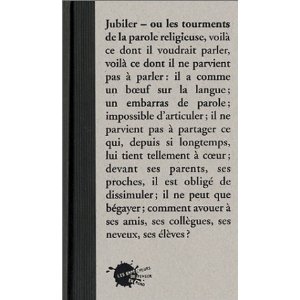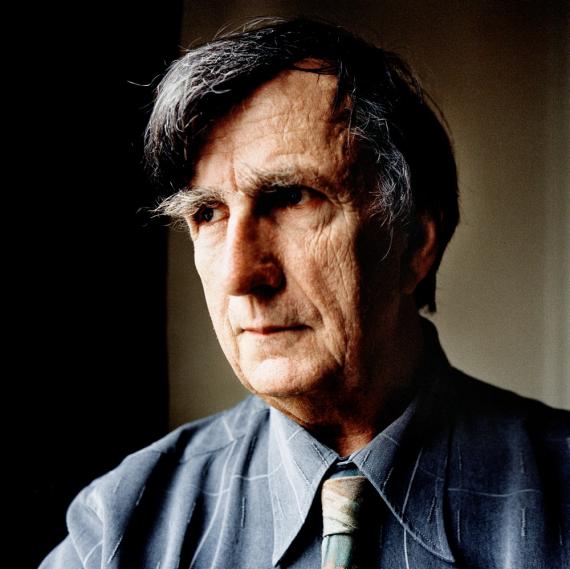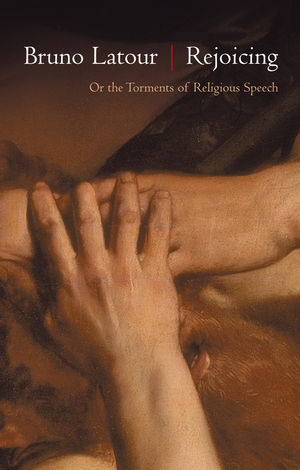 Bruno Latour’s Jubiler, ou les tourments de la parole religieuse (Les empêcheurs de penser en rond, 2002) is set to come out this year in English wish Polity Press as Rejoicing: Or the Torments of Religious Speech. Though Latour claims that the book exhibits a rigorously scientific approach, it certainly reads as something of a complex literary confession, flowing in and out of first, second and third person voices without clear indication of the switch.
Bruno Latour’s Jubiler, ou les tourments de la parole religieuse (Les empêcheurs de penser en rond, 2002) is set to come out this year in English wish Polity Press as Rejoicing: Or the Torments of Religious Speech. Though Latour claims that the book exhibits a rigorously scientific approach, it certainly reads as something of a complex literary confession, flowing in and out of first, second and third person voices without clear indication of the switch.
The English blurb states that the text addresses ‘the necessity of devising a way of writing that brings to the fore this elusive form of speech to render it audible again’. I found two elements of this new approach to thinking religious speech particularly engaging: the analogy between religious speech and lovers’ discourse, and understanding the religiousness of religious speech in terms of the distinction between rhythm and melody. I will address the latter idea in this post and the former, I hope, in a subsequent reflection.
To cut to the chase, Latour rounds off a series of reflections on commonalities between lovers’ speech and speaking religiously by saying that, for amatory as well as for religious language, we must be sensitive to the difference between its melody (its constantly changing content, stories and expressions) and its rhythm (that which remains consistent through all the changing content). This distinction does the work of allowing Latour a way of accounting for the importance of speaking religiously that does not oblige one to take literally the content of religious speech.
The notion of ‘not taking literally’ needs clarification here, for Latour is far from treating religious speech as ‘mere’ metaphor or as ‘mere’ myth. Latour has short shrift for those who want the message of the bible (it is primarily the bible with which he engages: Genesis and the gospels of Mark and John) to vanish in a puff of metaphor, and he has no time for the demythologisers who have no reliable way of deciding where their demythologising should stop. In one of his characteristically memorable and humourous images he characterises such critics as striking a blow with a philosophical hammer which, far from shattering its intended object, ricochets and knocks them out themselves. In contrast, Latour describes his own approach as a new sort of faithfulness, a renewal of everything without getting rid of anything, a ‘renewing repetition’ (répétition de renouvellement):
Oui, mais comment marcher droit ? À quoi être à nouveau fidèle et comment ? Que peut vouloir dire « tout renouveler sans rien trier » — surtout qu’il faut bien en même temps trier, discerner, reprendre, défaire, rejeter ? Pas de doute, je me trouve bien au milieu des tourments de la parole religieuse. (p. 76)
Yes, but how are we to keep on the straight and narrow? To what should we be faithful now, and how? What can “renew everything, get rid of nothing” mean – above all that we must at the same time get rid, discern, take up again, dismantle, reject? There can be no doubt about it; I find myself right in the middle of the torments of religious speech. (my translation).
In ‘renewing repetition’ it is the not the melody but the rhythm that is important. It is no good dealing with the sacred stories themselves; we need access to the ‘machine’ which has produced them and can produce them again (p. 115). Melody informs, but rhythm transforms, and religious speech is not there (or should not be understood to be there) to inform us at all, Latour insists, where ‘inform’ takes on all the negative ballast of what Latour often refers to as ‘double-click’ information. No, religious speech is not there to inform but to transform:
les anges ne transportent pas de messages ; ils modifient ceux à qui ils s’adressent. Ce qu’ils transfèrent n’est pas un contenu d’information, mais un nouveau contenant. (p. 39)
angels do not bring messages ; they change those whom they address. What they transfer is not informational content, but a new container. (my emphasis).
This dismissal of content is a recurring theme in Jubiler: Latour argues that in Peter’s Pentecost sermon Acts 2 there is no mystery (in the biblical sense) other than the call to convert (p. 51), and we are mistaken in seeking in religious language a communication of information from the past to the present for the text in fact transforms the reader from (depuis) the present to (jusqu’au) the past (p. 104-5). To do anything else would be, for Latour, to treat Genesis like the speaking clock.
In order to hold this position, Latour relies on a strict dichotomy between information and transformation that pushes him into the rather awkward position of having to argue that there is no discernible message (information, news) in Christianity whatsoever:
Pour traduire le mot grec « évangile », on parle toujours de la bonne nouvelle, mais personne encore, depuis que le monde est monde, n’a expliqué quelle était cette fameuse nouvelle. (p. 146)
When we are translating the Greek for ‘gospel’ we always speak of the good news, but no-one to this day, since the beginning of time, has explained what this notorious news was.
To be sure, Latour maintains that rhythm and melody are inseparable (p. 97) and that the relation between them cannot be definitively stabilised (p. 96), but nevertheless he is very clear that it is the essential rhythm and not the contingent melody, the attributes not the substance, the transformation not the information that makes religious speech religious (though we might also say it is the information that makes religious speech speech).
 This dichotomy, and the contortions into which it forces Latour in Jubiler, seems at odds with one of his own signature gestures, his own rhythm that persists through the melodies of his different works, namely his critique of the dichotomous thinking of modernity (subject/object, representations/things, theory/practice). In the context of this repeated Latourian drumbeat it is strange that he draws the distinction between information and transformation as quite such a stark dichotomy. Of course, Latour has his reasons: he is seeking to show the continued relevance of religious language to a culture deaf to its message, a culture for which the content of the old stories has lost its resonance. (In passing, we might question to what extent this is and will remain true in an increasingly globalised modernity, but that thought will take us too far from the focus of this post). Latour forces the dichotomy to the extent that we seemingly have to reject the religious significance of determinate content all together, lest we pivot to the other pole of the dichotomy and treat religious writing like a scientific textbook. A third option remains unexplored by Latour: that religious speech might transform in and through its message.
This dichotomy, and the contortions into which it forces Latour in Jubiler, seems at odds with one of his own signature gestures, his own rhythm that persists through the melodies of his different works, namely his critique of the dichotomous thinking of modernity (subject/object, representations/things, theory/practice). In the context of this repeated Latourian drumbeat it is strange that he draws the distinction between information and transformation as quite such a stark dichotomy. Of course, Latour has his reasons: he is seeking to show the continued relevance of religious language to a culture deaf to its message, a culture for which the content of the old stories has lost its resonance. (In passing, we might question to what extent this is and will remain true in an increasingly globalised modernity, but that thought will take us too far from the focus of this post). Latour forces the dichotomy to the extent that we seemingly have to reject the religious significance of determinate content all together, lest we pivot to the other pole of the dichotomy and treat religious writing like a scientific textbook. A third option remains unexplored by Latour: that religious speech might transform in and through its message.
![]()
